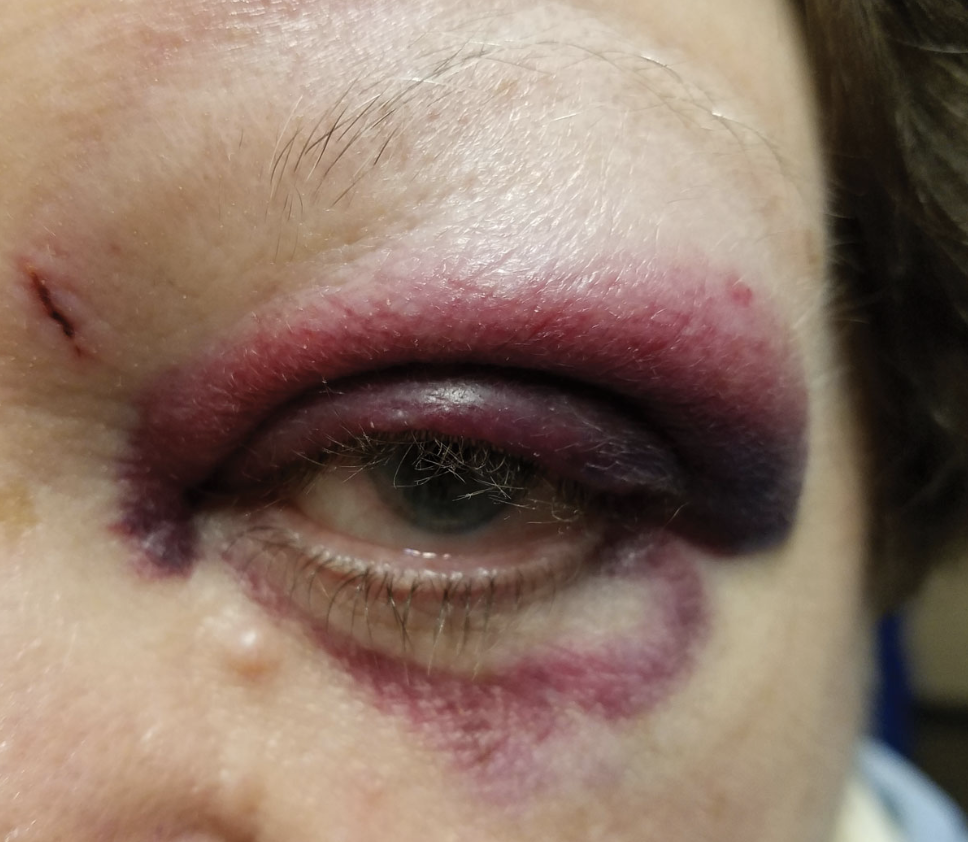 |
| While most of the patients who sustained domestic violence-related ocular injuries were young women with less privileged SES, older adults and patients with Medicare insurance were significantly more likely to be hospitalized. (Note: Patient in photo was not a victim of domestic violence). Photo: Paul C. Ajamian, OD. Click image to enlarge. |
Domestic violence is a broad term that encompasses various forms of maltreatment, which manifest as physical, sexual or emotional actions for the purpose of control and influence over another individual. Many have noted that ocular and facial injuries are often suggestive of intimate partner violence among women of reproductive age. A team of researchers assessed the epidemiology of domestic violence-related ocular injuries in US emergency departments (EDs). Despite the intersection between domestic violence and ocular injuries, these related injury patterns have not been well described in the literature. They found that the mean incidence of domestic violence-related ocular injuries among adult patients was 1.09 per 100,000 adult population. Adults between the ages of 18 to 39, women and patients of less privileged socioeconomic status were the most predominant demographics (female patients, 84.5%; mean age, 34.3).
This analysis was a retrospective, cross-sectional study of patients with a diagnosis of domestic violence and diagnosis of ocular injury in the Nationwide Emergency Department Sample (NEDS) from a 10-year period. The researchers identified patient- and hospital-level variables associated with domestic violence-related ocular injuries and calculated annual incidence rates using US Census data. Adjusting for inflation using the Consumer Price Index, they also calculated mean and total charges.
Domestic violence-related ocular injuries were most prevalent among patients in the lowest income quartile (39.1%) and on Medicaid (37.4%). Most ED visits presented to metropolitan teaching (55.4%), non-trauma (46.7%) and South regional (30.5%) hospitals. The most common ocular injury was contusion of eye/adnexa (61.1%), and being struck by/against an object was the most common mechanism of injury (18.9%). The hospital admission rate was 5.2% with a mean hospital stay of 2.9.
The inflation-adjusted mean cost for medical services was $38,540 per encounter with an average increase of $2,116 per encounter, annually. The likelihood of hospital admission increased for patients aged ≥60 years old, on Medicare and with open globes or facial/orbital fractures.
“Although the purpose of this study was not to compare the severity of domestic violence-related ocular injuries vs. non-domestic violence-related ocular injuries, future studies could investigate whether higher charges are related to injuries requiring more imaging or procedures,” the researchers suggested.
The team believed that it is essential to outline this epidemiology so that eyecare providers can better identify and document domestic violence-related ocular injuries. In doing so, the profession might strive to improve the quality of care for a historically vulnerable patient population.
“This study offers insight into the relationship between oculofacial injuries and violence against women as well as raises questions about the current rate of domestic violence screening and referrals among eyecare providers,” they concluded in their paper. “Future studies and policies should be targeted at increasing the identification and documentation of this occurrence, to better facilitate referrals to appropriately trained service agencies.
Andoh JE, Mehta SK, Chen EM, et al. Domestic violence-related ocular injuries among adult patients: data from the nationwide emergency department sample, 2008–2017. Ophthalmic Epidemiol. June 22, 2023. [Epub ahead of print]. |

